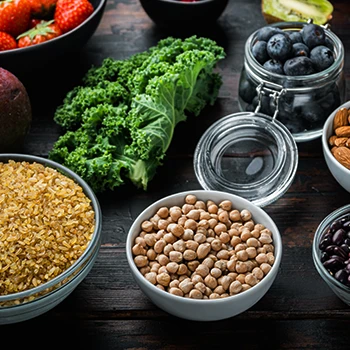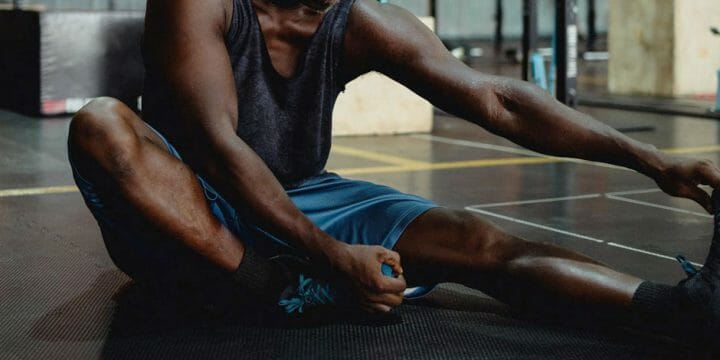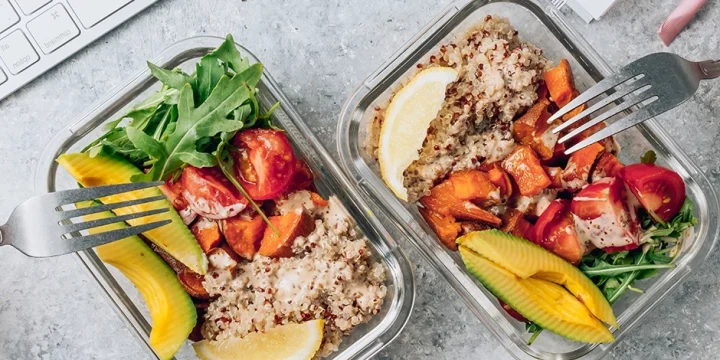Planning your food intake for muscle mass and losing fat is not an easy task. And many amateurs who don’t have the support of a team of dietitians and chefs can end up struggling with either gaining muscle or fat loss.
The main reason is that people don’t understand that you have conflicting requirements for your macro-intake depending on whether you want to lose fat or bulk up.
As a certified personal trainer, I got together with my dietitian to research the ideal approach that athletes should take to achieve their body composition.
Quick Summary
- To effectively balance macros for muscle gain and fat loss, it's crucial to understand and adjust your daily calorie intake and macronutrient ratio.
- A macro ratio of 30/30/40 for fat/protein/carbs is generally recommended for building lean muscle mass, with adjustments based on individual calorie needs.
- A study from the National Center for Biotechnology Information found that high-protein diets (HPD) not only reduce body weight by decreasing fat mass and preserving fat-free mass but also enhance satiety and energy expenditure without adverse effects on bone density or renal function, with clinical trials ranging from 6-12 months demonstrating effectiveness in weight loss and prevention of weight regain.
- In my opinion, the key to successful macro management lies in personalization and regular adjustment to align with changing fitness goals and body responses.
How Do You Figure Out Your Macros For Building Muscle?

You figure out your macros for building muscle mass by calculating total daily energy expenditure (TDEE).
The good news is that you won’t have to be a math genius as there’s a simple calculator that you can use [1]. This number represents the total calories you require to sustain your current activity levels, and it's crucial to account for all the muscle-building workouts you engage in.
Once you have your daily calorie intake, I recommend adding a buffer of about 10% to 20% before considering the macronutrient ratio.
With that calorie surplus, you can now apply the general rule for building lean mass that my dietitian shared with me: a 30/30/40 ratio for fat/protein/carbs. Suppose your goal is to gain muscle, and you require 3,000 calories per day.
Then you would need 900 calories from protein, and with 1 gram of protein providing four calories, you’d need 225 grams of protein [2]. Similarly, for fat, you’d need about 900 calories from healthy fats or 100 grams as it delivers nine calories per gram.
And for carbs, you’ll need 1,200 calories or 300 grams.
Based on my experience, to effectively support muscle gain and optimize results, it's essential to consider your body weight and muscle-building goals when determining your macronutrient ratios.
Protein is vital for muscle growth and repair, while carbs offer the necessary energy for intense workouts and glycogen replenishment. Including healthy fats in your diet promotes hormone production and overall wellness.
Collaborating with certified fitness professionals or nutritionists can further assist in tailoring your macronutrients to suit your specific needs and enhance your muscle building journey.

How Do You Figure Out Your Macros For Burning Fat?

You figure out your macros for burning fat by working out your TDEE.
You can use the same calculator as for muscle growth above. But the difference is that you then eat fewer calories than your TDEE suggests. When losing fat is your top priority, then you want to reduce the macros that the body most easily turns into fat reserves and increase the macros that help with fat loss.
What does that mean specifically?
What you need to do is switch to a low-carb and high-protein diet. One of the studies from the National Center for Biotechnology Information website has shown a direct link between eating more protein and fat storage [3].
In my experience, this doesn’t mean going to extreme lows for carbs like on the keto diet, but it can still minimize fat gain.
Using the same approach as above for working out the exact amounts, let’s say your daily calorie deficit is now 2,700 for weight loss and cutting, then your healthy fats should make up 810 calories, or about 90 grams. Your protein is now 1,080 calories or 270 grams. And your carbs are 810 calories or about 200 grams.
“When it comes to figuring out what to eat for weight loss, the most important factor is eating less. When you consume less calories than you spend you will lose weight and the diet that helps you lose weight best will be the one that allows you to consume less calories without causing much distress or lethargy.”
- Kamal Patel, Co-founder & Editor at Examine.com
Why Do Calories Come Into Play?
You’ve probably heard people talk about the fact that to burn fat, you have to eat less. Essentially, your calorie intake has to be lower than your expenditure to force your body to get energy from stored fat, according to one of the studies from the PubMed website [4].
However, when it comes to a goal of muscle growth, you need to do the opposite and eat more protein, carbs, and fat for a calorie surplus [5].
What can happen, though, is that along with the muscle gain, you also notice a fat gain.
You have to keep a close eye on this, as the more fat you accumulate while gaining muscle, the longer your cutting phase might need to be. But there are some tips to limit this. More on that shortly.
Tips For Counting Your Macro Intake

Now, before you think that you’re going to have to work all this out with pen and paper, let me tell you that there’s a much simpler solution.
Whether you’re in a calorie deficit or surplus phase, start journaling all your food intake with the Noom app or another similar application.
Even Noom's free version will help with tracking and calculating your macros intake. All you need to do is pick your food and ingredients and enter how many grams you eat.
At the end of the day, you’ll have a number for your calories along with the overall macros.
Counting macros couldn’t be easier, and it just takes a few minutes each day.
Measuring Your Progress
As you gain muscle and/or body fat, it becomes more important to keep an eye on your progress. The tricky thing is that you might not record a weight reduction on the scales while still losing fat reserves.
That’s because muscle tissue is denser than fat [6].
As you gain muscle, you can record quite substantial weight gain, but that’s not a negative.
To measure this accurately, I suggest that you either invest in a body fat caliper or go for a regular DEXA scan [7].
This will tell you the exact ratio of muscle, fat, and bone in your body, and it will tell you a lot about your progress from one scan to the next.
Can You Balance Muscle Building And Fat Loss

Yes, you can balance building muscle mass and fat loss, but does your body burn fat or muscle first?
This is a difficult task that depends on several factors.
Researchers have shown that how your body builds muscle and stores fat is not just dependent on your diet and metabolism but also on your hormone balances [8].
So you end up with multiple different things that could be competing for either growing muscle fibers or fat reserves, or both at the same time.
Rather than let that become a highly frustrating process, I generally recommend that people focus on lean bulk and muscle building and then go through cutting phases where they religiously count calories and reduce fat.
Taking Advantage Of Supplements

When you want to build muscle and lose flabby stuff over a certain time period, then there are two types of supplements you’ll need to rely on.
Whey Protein
You’ll need a lot of amino acids to build muscle consistently, as these are the building blocks of muscle fiber [9].
And one of the best ways to get the full range of protein your body needs is with a high-quality whey protein [10]. That should ideally be a whey isolate from grass-fed cows.
The great thing is that this supplement can also help you boost your protein intake for weight loss.
Fat Burners
Fat burners for men or women fat burners are not some form of magic pills that promise weight loss while you’re watching Love Island with a box of donuts.
But they are designed to trigger a process called thermogenesis that elevates your basal metabolic rate and subsequently leads to more efficient fat loss [11].
FAQs
Do You Need To Count Macros To Build Muscle?
Yes, you need to count macros to build muscle. It’s important to get the right balance of carbs, fat, and protein to provide the energy for training and ingredients for repairing and building muscle.
Should You Manually Calculate Your Macro Intake To Build Muscles And Lose Fat?
No, you shouldn’t manually calculate your macro intake to build muscles and lose fat. There are many different apps available that will allow you to enter your food consumption and then calculate the macros for you.
How Does Macro Tracking Affect Psychological Well-Being?
Macro tracking can sometimes lead to stress and obsessive behaviors, particularly if the focus becomes too rigid. It's important to balance macro tracking with a flexible mindset to maintain mental and emotional health.
Are Macro Ratios Different for Various Body Types?
Yes, macro ratios can vary depending on body types like ectomorph, mesomorph, and endomorph. Each body type may respond differently to carb, protein, and fat ratios, necessitating personalized macro planning.
Can Macro Balances Impact Sleep Quality and Muscle Recovery?
Different macro balances can significantly affect sleep quality and muscle recovery. For instance, higher protein intake can aid in muscle repair, while certain carbs may improve sleep quality.
What Is the Relationship Between Macros and Gut Health?
The balance of macros can influence gut health, as high-fiber carbs promote a healthy gut microbiome, while excessive fats might lead to digestive issues. It's crucial to find a macro balance that supports both fitness goals and gut health.
How Sustainable Are Macro-Focused Diets in the Long Term?
While macro-focused diets can be effective, their long-term sustainability varies among individuals. It's essential to adapt macro tracking to fit into a lifestyle, ensuring it's both manageable and enjoyable for prolonged periods.
References:
- https://tdeecalculator.net/
- https://www.nal.usda.gov/programs/fnic#faq--how-many-calories-are-in-
- https://www.ncbi.nlm.nih.gov/pmc/articles/PMC7539343/
- https://pubmed.ncbi.nlm.nih.gov/18025815/
- https://www.ncbi.nlm.nih.gov/pmc/articles/PMC6942464/
- https://www.runnersworld.com/nutrition-weight-loss/a25607493/muscle-weighs-more-than-fat/
- https://health.ucdavis.edu/sports-medicine/resources/dxa-info
- https://www.webmd.com/diet/default.htm
- https://www.scientificamerican.com/article/do-amino-acids-build-bigger-muscles/
- https://www.ncbi.nlm.nih.gov/pmc/articles/PMC6245118/
- https://www.sciencedirect.com/topics/agricultural-and-biological-sciences/thermogenesis
About The Author
You May Also Like






